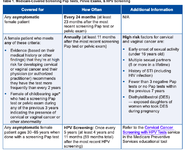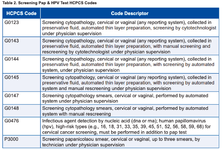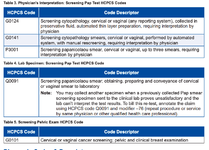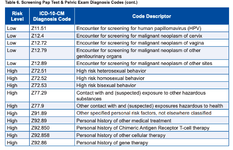A screening Pap test (called a Pap smear) is a lab test used to detect early cervical cancer.A health care provider takes a cervical cell sample and interprets the test results
.● A screening pelvic exam helps detect precancers, genital cancers, infections, sexually transmittedinfections (STIs), reproductive system abnormalities, and other genital and vaginal problems.
● Human Papillomavirus (HPV) screening is also a preventive service. The test detects the virusthat causes cervical cancer or warts.
Determining whether the patient is being seen for a diagnostic or screening Pap test will help you determine the appropriate ICD-10 code to submit to the laboratory. A diagnostic code should be used when there are signs or symptoms of disease. To help you determine if a Pap test was performed for diagnostic purposes, here are a few things to consider.

The patient preventive medicine services codes 99381-99397 include an age- and gender-appropriate physical exam. According to CPT Assistant, performing a pelvic and breast exam, as well as obtaining a screening Pap smear, are all part of the comprehensive preventive service and should not be reported separately.

HCPCS Codes for Physician’s Interpretation of Screening Pap Tests

HCPCS Code for Laboratory Specimen of Screening Pap Tests
If a patient presents for a symptom or complaint that requires a Pap smear for diagnosis, the physical exam and obtaining the Pap smear are part of the E/M service and are not separately reportable. Additionally, you would not use Q0091 in this instance because that is a code for obtaining a screening Pap smear, not a diagnostic one.
For Medicare patients who still need a Pap smear, use Q0091 when a screening Pap smear is obtained even if this service is provided in addition to a wellness visit.
A Medicare patient may have a pelvic and clinical breast exam performed alone as the only service performed that day, at the time of a problem oriented visit or on the day of a wellness visit. There is a HCPCS code for this, G0101.
Do not bill HCPCS code G0101 in addition to a preventive service reported with CPT® codes 99381—99397. Those codes include an age and gender appropriate physical exam and if needed, the pelvic and breast exam is part of that service. Most commercial payers do not recognize G0101.
G0101 requires a breast exam and a total of 7 of these exam elements, and the breast exam must be done to report G0101:
View attachment 1985


Instructions under Z01.411 and Z01.419 (routine gynecological exam with or without abnormal findings) indicate that the codes include a cervical Pap screening and instruct us to add additional codes for HPV screening and/or a vaginal Pap test. The instructions under Z01.411 (routine GYN exam with abnormal findings) state additional codes must be used to indicate any abnormal findings.
1st trimester: less than 14 weeks 0 days
2nd trimester: 14 weeks 0 days to 27 weeks 6 days
3rd trimester: 28 weeks 0 days to delivery
The ICD-10 coding guidelines instruct us that a routine outpatient prenatal visit without complications may be coded using one of the following codes first:
NON-MEDICARE PAYERS: INTERPRETATION OF PAP SMEAR
If the physician is billing for the interpretation of the Pap smear on behalf of the laboratory, he or she can report the appropriate laboratory code on the claim. A modifier 90 must be added to the interpretation code (eg, 88150–90). The modifier 90 (Outside Laboratory Services) indicates that the interpretation was performed by an outside laboratory and not in the physician’s office. Modifier 90 is necessary because laboratory interpretation of a Pap smear is not a waived office-based test under the Clinical Laboratory Improvement Amendments of 1988 (CLIA) regulations. The modifier also informs the payer that a fee should not be paid to the laboratory in addition to the one paid to the physician’s office.

 www.aafp.org
www.aafp.org

 codingintel.com
codingintel.com
 www.incytediagnostics.com
www.incytediagnostics.com
.● A screening pelvic exam helps detect precancers, genital cancers, infections, sexually transmittedinfections (STIs), reproductive system abnormalities, and other genital and vaginal problems.
● Human Papillomavirus (HPV) screening is also a preventive service. The test detects the virusthat causes cervical cancer or warts.
Determining whether the patient is being seen for a diagnostic or screening Pap test will help you determine the appropriate ICD-10 code to submit to the laboratory. A diagnostic code should be used when there are signs or symptoms of disease. To help you determine if a Pap test was performed for diagnostic purposes, here are a few things to consider.

The patient preventive medicine services codes 99381-99397 include an age- and gender-appropriate physical exam. According to CPT Assistant, performing a pelvic and breast exam, as well as obtaining a screening Pap smear, are all part of the comprehensive preventive service and should not be reported separately.
- A recent report from the American Academy of Family Physicians (AAFP) points out that codes 88141-88175 are meant for pathologists examining a specimen.
- 88141 Cytopathology, cervical or vaginal (any reporting system), requiring interpretation by physician (to be listed separately in addition to code for technical service)
- 88142 Cytopathology, cervical or vaginal (any reporting system), collected in preservative fluid, automated thinlayer preparation; manual screening under physician supervision)
- 88143 With manual screening and rescreening under physician supervision
- 88147 Cytopathology smears, cervical or vaginal; screening by automated system under physician supervision
- 88148 Screening by automated system with manual rescreening under physician supervision
- 88155 Cytopathology, slides, cervical or vaginal definitive hormonal evaluation (e.g. maturation index, karyopyknotic index, estrogenic index). List separately in addition to code(s) or other technical and interpretive services.
- 88164 Cytopathology, slides, cervical or vaginal (the Bethesda System); manual screening under physician supervision
- 88165 With manual screening and rescreening under physician supervision
- 88174 With manual screen and computer rescreen
- 88175 Cytopathology, cervical or vaginal (any reporting system), collected in preservative fluid, automated thin layer preparation; screening by automated system, under physician supervision

HCPCS Codes for Physician’s Interpretation of Screening Pap Tests

HCPCS Code for Laboratory Specimen of Screening Pap Tests
- Q0091 Screening papanicolaou smear; obtaining, preparing and conveyance of cervical or vaginal smear to laboratory
If a patient presents for a symptom or complaint that requires a Pap smear for diagnosis, the physical exam and obtaining the Pap smear are part of the E/M service and are not separately reportable. Additionally, you would not use Q0091 in this instance because that is a code for obtaining a screening Pap smear, not a diagnostic one.
For Medicare patients who still need a Pap smear, use Q0091 when a screening Pap smear is obtained even if this service is provided in addition to a wellness visit.
A Medicare patient may have a pelvic and clinical breast exam performed alone as the only service performed that day, at the time of a problem oriented visit or on the day of a wellness visit. There is a HCPCS code for this, G0101.
Do not bill HCPCS code G0101 in addition to a preventive service reported with CPT® codes 99381—99397. Those codes include an age and gender appropriate physical exam and if needed, the pelvic and breast exam is part of that service. Most commercial payers do not recognize G0101.
G0101 requires a breast exam and a total of 7 of these exam elements, and the breast exam must be done to report G0101:
- Inspection and palpation of breasts for masses or lumps, tenderness, symmetry, or nipple discharge
- Digital rectal examination including sphincter tone, presence of hemorrhoids, and rectal masses
- External genitalia
- Urethral meatus
- Urethra
- Bladder
- Vagina
- Cervix
- Uterus
- Adnexa/parametria
- Anus and perineum
View attachment 1985


A Pap test is considered screening if it meets any of the following criteria:
- Physician recommends the procedure
- Patient is of childbearing age
- No Pap test in the past three years
Screening Pap tests have several codes to choose from:
- Routine gynecological exam without abnormal findings (Z01.419)
- Routine gynecological exam with abnormal findings (Z01.411)
- Cervical Pap test (Z12.4)
- Vaginal Pap test (Z12.72)
- Pap test other genitourinary sites (Z12.79)
A Medicare high-risk patient may receive a Pap test on an annual basis. High-risk (Z91.89) factors include:
- Early onset of sexual activity (under 16 years of age)
- Multiple sex partners (5 or more)
- History of sexually transmitted disease
- Fewer than 3 negative Pap tests in 7 years
- DES exposure during pregnancy (P04.8)
Additional ICD-10 codes needed (MANDATORY)
If a vaginal Pap test or additional testing is being performed at the time of the Pap test, additional codes are necessary to support the medical necessity for each test.Instructions under Z01.411 and Z01.419 (routine gynecological exam with or without abnormal findings) indicate that the codes include a cervical Pap screening and instruct us to add additional codes for HPV screening and/or a vaginal Pap test. The instructions under Z01.411 (routine GYN exam with abnormal findings) state additional codes must be used to indicate any abnormal findings.
Some additional codes that may be needed for additional non-symptomatic screenings include:
- Screening for malignant neoplasm of vagina (Z12.72)
- Screening for HPV (V11.51)
- Screening for chlamydia (Z11.8)
- Screening for STD (Z11.3)
- Exposure to venereal disease (Z20.2)
- Exposure to other viral diseases (Z20.828)
Some additional codes that may be needed for additional testing when the patient presents with symptoms include:
- Pelvic or perineal pain (R10.2)
- Dyspareunia (N94.1)
- Vaginitis, acute (N76.0)
- Vaginitis, chronic (N76.1)
- Vulvitis, acute (N76.2)
- Vulvitis, chronic (N76.3)
A Pap test is considered diagnostic if it meets any of the following criteria:
A) The patient has been treated for or is being treated for cancer of the cervix, uterus or vagina:
- Endocervical cancer (C53.0)
- Endometrial cancer (C54.1)
- Exocervical cancer (C53.1)
- Myometrial cancer (C54.2)
- Cervical cancer, unspecified (C53.9)
- Uterine fundal cancer (C54.3)
- History of cervical cancer (Z85.41)
- Uterine cancer, unspecified (C55)
- Vaginal cancer (C52)
- History of uterine cancer (Z85.42)
- History of vaginal cancer (Z85.44)
B) The patient is being seen for follow up on a previous abnormal Pap test
- Cervical Pap with ASCUS (R87.610)
- Vaginal Pap with ASCUS (R87.620)
- Cervical Pap with ASC-H (R87.611)
- Vaginal Pap with ASC-H (R87.621)
- Cervical Pap with LGSIL (R87.612)
- Vaginal Pap with LGSIL (R87.622)
- Cervical Pap with HGSIL (R87.613)
- Vaginal Pap with HGSIL (R87.623)
- Cervical high-risk HPV positive (R87.810)
- Vaginal high-risk HPV positive (R87.811)
- Cervical Pap with evidence of malignancy (R87.614)
- Vaginal Pap with evidence of malignancy (R87.624)
- Cervical Pap with other abnormal finding (R87.619)
- Vaginal Pap with other abnormal finding (R87.628)
C) Abnormalities of the vagina, cervix, uterus, ovaries or adnexa are found on exam:
- Routine gynecological exam with abnormal finding (Z01.411)
- An additional code is needed for the abnormal finding
D) The patient is experiencing signs or symptoms that might reasonably be related to a gynecological exam:
- Menorrhagia (N92.0)
- Metrorrhagia (N92.1)
- Post-coital bleeding (N93.0)
- Irregular menstruation, unspecified (N92.6)
- Other irregular menstruation (N92.5)
- Postmenopausal bleeding (N95.0)
- Inflammatory disease cervix (N72)
- Mild cervical dysplasia - CIN I (N87.0)
- Moderate cervical dysplasia - CIN II (N87.1)
Pregnancy and the Pap test.
When a Pap test is being performed in connection to routine pregnancy care, the first ICD-10 code should indicate that the encounter is for routine pregnancy care. Under ICD-10, we are required to select diagnosis codes that indicate the trimester. Trimesters are defined as follows:1st trimester: less than 14 weeks 0 days
2nd trimester: 14 weeks 0 days to 27 weeks 6 days
3rd trimester: 28 weeks 0 days to delivery
The ICD-10 coding guidelines instruct us that a routine outpatient prenatal visit without complications may be coded using one of the following codes first:
- Encounter for supervision of normal first pregnancy, 1st trimester (Z34.01)
- Encounter for supervision of normal first pregnancy, 2nd trimester (Z34.02)
- Encounter for supervision of normal first pregnancy, 3rd trimester (Z34.03)
- Encounter for supervision of other normal pregnancy, 1st trimester (Z34.81)
- Encounter for supervision of other normal pregnancy, 2nd trimester (Z34.82)
- Encounter for supervision of other normal pregnancy, 3rd trimester (Z34.83)
NON-MEDICARE PAYERS: INTERPRETATION OF PAP SMEAR
If the physician is billing for the interpretation of the Pap smear on behalf of the laboratory, he or she can report the appropriate laboratory code on the claim. A modifier 90 must be added to the interpretation code (eg, 88150–90). The modifier 90 (Outside Laboratory Services) indicates that the interpretation was performed by an outside laboratory and not in the physician’s office. Modifier 90 is necessary because laboratory interpretation of a Pap smear is not a waived office-based test under the Clinical Laboratory Improvement Amendments of 1988 (CLIA) regulations. The modifier also informs the payer that a fee should not be paid to the laboratory in addition to the one paid to the physician’s office.

How to properly code for a Pap smear
Screening for cervical cancer is often included in the physical exam portion of a preventive medicine service. Follow this advice to see when you can bill separately for a Pap smear.

Billing for pap smear
How do medical practices bill for pap smears, done at an office visit or preventive medicine service? It depends.


